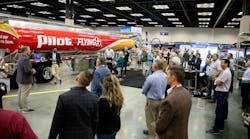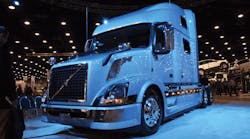MERITOR Inc showed off a range of current and future technologies aimed at improving fuel economy and operational efficiency during the Mid-America Trucking Show in Louisville, Kentucky. The display reinforced the company's reputation as a leader in cutting-edge technologies for the commercial truck market.
“Braking, driveline, and axle solutions — Meritor delivers them all, and the benefits show up on our customers' bottom line,” said Joe Elbehairy, Meritor vice-president of engineering. “We've identified and fine tuned the technologies that benefit our customers the most, and are developing new products engineered to provide extraordinary benefits.”
Dale Eschenburg, Meritor senior director of engineering, added: “The Advanced Rear Axle concept we are featuring at MATS is a mix of current technology as well as advancements we are working on for the future. We are showing combination that has can enable performance optimized weight reductions and corresponding payload increases of more than 1,000 pounds and increase fuel efficiency by 10%.”
The rear axleconcept featured in Meritor's Advanced Technology Center starts with a 6×2 concept, based on the successful 17X rear axle sold in Europe, which is capable of handling the most powerful truck engines in the industry. Additional technologies include:
- Meritor LogixDrive — the industry's first intelligent axle system, which debuted in September 2010 in Europe, controls the amount of lube in the axle based on operating conditions thereby improving fuel economy;
- Aluminum Carrier — 100-pound weight savings compared with a traditional case ductile iron carrier;
- 2.47 Drive Ratio — the fastest ratio in the industry currently available on the Meritor 14X. This ratio, when paired with a direct drive transmission, can increase fuel economy by more than 1% compared with common rear axle and overdrive transmission ratios, even faster ratios are being developed;
- Carbon Fiber Bowl — extremely lightweight future technology weighing roughly 1/5th the weight of steel, resulting in savings of approximately 25 pounds. Additionally, the technology offers the ability to mold to various shapes to house internal axle advancements;
- Meritor DualTrac — designed to optimize the use of wide base single tires or dual tires and offers the ability to improve bearing life compared to standard track axle with outset wheels, while providing the ability to convert back to duals if needed;
- Aluminum Tag Axle — another possible use of lightweight aluminum that results in major weight reductions with optimized section modulus in critical areas to deliver needed strength with larger payload gains;
- Q Plus Cam Brakes with advance friction material — currently in production, designed to meet the stringent stopping requirements of FMVSS-121 that go into effect for most highway tractors starting in August 2011. Q Plus Cam Brakes provide a customer with stopping distance performance similar to disc brakes at a much lower total cost of ownership;
- MeritorWABCO Air Disc Brakes — twin piston design for optimized load distribution, providing the ultimate in stopping force and pad life;
- SteelLite X30 Brake Drums — in production today, offers the ability to reduce 20 pounds per wheel-end and are similar with braking systems which meet the stringent FMVSS121 regulation revisions;
- Aluminum Hubs — are available through Meritor supplier partners and reduce weight by 120 pounds for a tandem axle tractor configuration;
- Titanium Brackets — every pound matters and the potential opportunities are vast, for example through the use of high-strength titanium brackets, approximately 30 pounds of weight can be reduced compared with traditional steel;
- Intelligent Traction Control — automatic differential lock and enhanced load transfer to the drive axle, engages and disengages below and above 25 mph in instances of low traction providing a 6×2 with 6×4-like traction in most operating conditions. ♦










